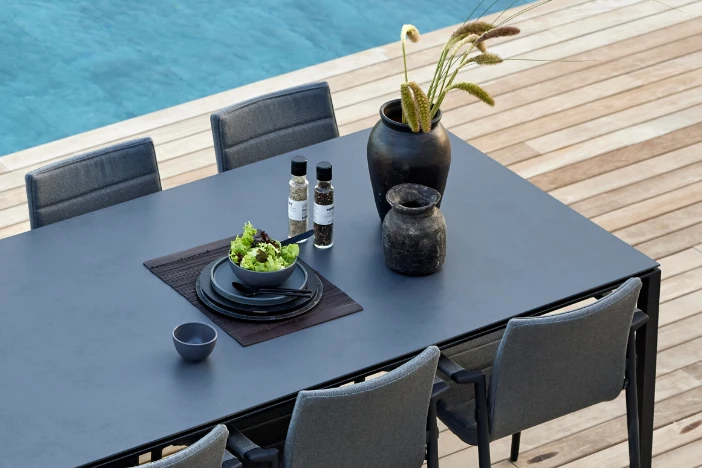
Helpful hints for maintaining outdoor tabletops
Dining alfresco and enjoying drinks with family and friends becomes more frequent as temperatures rise. No matter how careful you are, spills are bound to happen and your outdoor dining or occasional tables should be cleaned frequently. Tabletops are made of many materials that match your decor style. This section of our guide provides some quick tips for cleaning and maintaining a few more popular tabletop materials.
Outdoor tabletops – Safe & unsafe cleaners by material
Outdoor tabletops are made from a range of materials, each with its own sensitivity to certain cleaning agents. Using the wrong cleaner can dull the finish, scratch the surface, or even cause permanent staining or degradation. It’s especially true for high-end materials like slate, HPL (high-pressure laminate), and ceramic. The table below will help you choose the right cleaning products for each tabletop type, while avoiding those that may cause damage over time.
| Material | Safe cleaners | Avoid these |
|---|---|---|
| HPL (High-Pressure Laminate) | Mild dish soap, diluted vinegar solution, ammonia-based glass cleaner | Abrasive powders, scouring pads, bleach |
| Tempered Glass | Standard glass cleaner, vinegar-water mix, mild soap | Steel wool, gritty cloths, abrasive sponges |
| Ceramic | Soft dish detergent, pH-neutral cleaners, warm water | Harsh acids, bleach, ammonia, abrasive scrubbers |
| Slate | Mild soap, hydrogen peroxide (for stains), soft cloth | Vinegar, lemon juice, acidic or citrus-based cleaners |
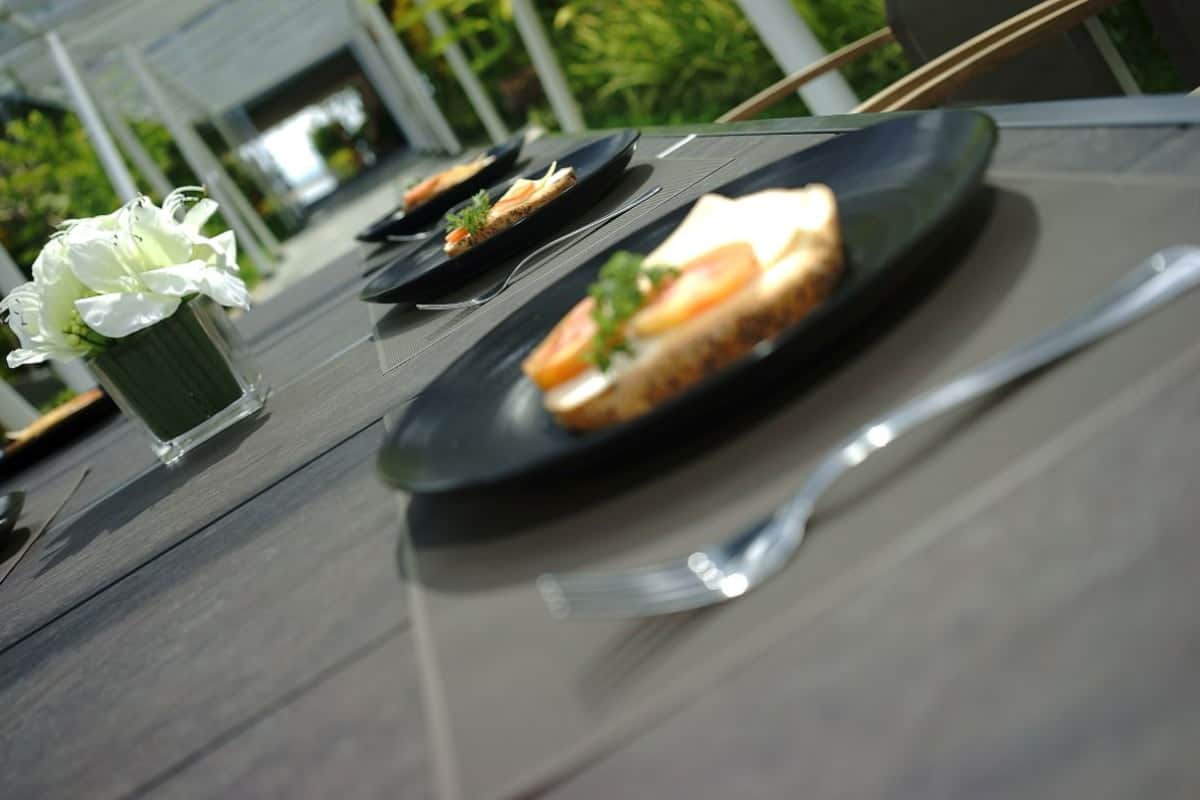
Cleaning high-pressure laminate (HPL)
This contemporary material is strong and bacteria-resistant. It also doesn’t get nicked up very easily [Ghorbani, Mahendran, van Herwijnen, Liebner & Konnerth 2018]. High-pressure laminate has an elegant look and stands up in all kinds of weather, making it a great choice for upscale outdoor settings. For the most part, it’s also low maintenance.
- Wipe down the surface using a damp microfiber or soft cloth
- Clean most stains with water and ordinary liquid dish soap
- Wipe again using a cloth using just clean water
- Wipe away all of the liquid and let air dry in the shade
Do not use rough powders or scouring pads. High-pressure laminates can get dull or scratched. This makes the tabletop more likely to stain in the future. Clean difficult stains with a dab of concentrated detergent and a soft-bristled brush. Use vinegar or ammonia-based glass cleaners on greasy marks. Clean HPL tabletops 2-3 times a year, but address spills and stains immediately.
Cleaning tough stains out of HPL
HPL surfaces resist general wear but can be vulnerable to dyes and pen marks if not cleaned promptly.
- Ink or Marker Stains – Gently dab the stain with a cloth soaked in isopropyl alcohol. You can also use acetone-free nail polish remover. Rinse with mild soap and water afterward.
- Food or Beverage Stains – Wipe down with a warm, soapy sponge. For dried-on spills, a soft nylon brush can help lift the residue.
- Greasy Residue or Lotion – Use a gentle ammonia-based glass cleaner and a soft cloth, then rinse with water.
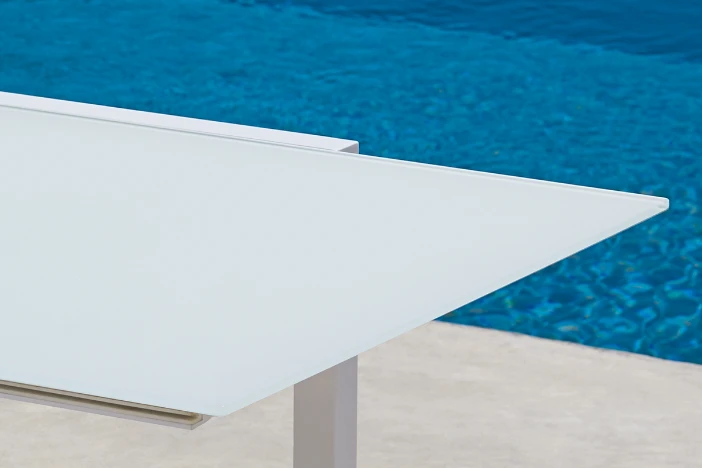
How to clean tempered glass
Glass tabletops require very little maintenance and are relatively easy to clean. Insect and bird droppings may take extra elbow grease but refrain from using steel wool or any abrasive pad.
- Wipe down the surface with a microfiber cloth and mild soap or detergent
- Rinse with water or wipe with a damp cloth
- Let the table air-dry
Cleaning tempered glass tabletops every two weeks and the underside once a month. Carefully place or move objects on the glass. Otherwise, they may leave scratches on the surface which cannot be removed. Some objects, left in place over time, may cause lime deposits to form. Use a glass cleaner or mild vinegar cleaning solution to remove these deposits and wipe clean with a soft cloth or paper towel. This should also keep the tempered glass surface streak free.
Taking care of challenging stain on glass
Tempered glass is durable and easy to clean but it’s prone to cosmetic issues like streaks or mineral deposits from hard water.
- Water Spots – Spray with a 1:1 solution of white vinegar and water. Let sit for a minute, then buff with a microfiber cloth to prevent streaking.
- Grease or Sunscreen Smudges – Use standard glass cleaner or rubbing alcohol for oily residues. Follow with a clean, dry cloth.
- Sticky Residue (e.g. tree sap) – Rub gently with a cloth dampened in isopropyl alcohol, then wash with soap and water.
BUY HPL PATIO FURNITURE
Best way to clean ceramic tabletops
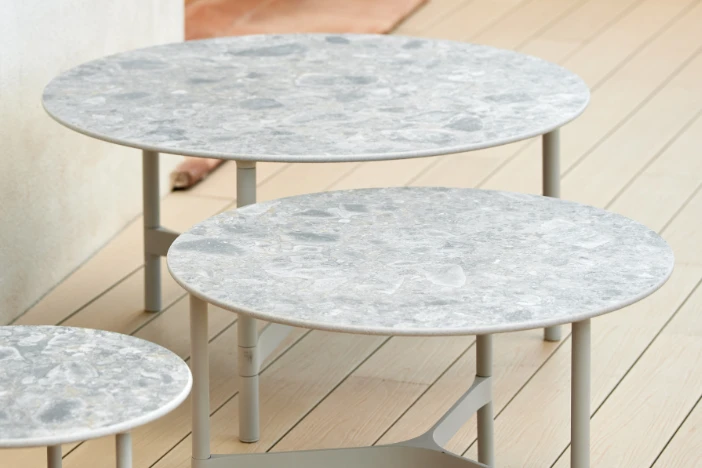
Contemporary ceramic sheets used for tabletops are thin yet durable and are resistant to weather and scratching. Consequently, they are relatively easy to maintain and need cleaning 2-3 times a year (excluding spills).
- Clean the tabletop using a soft microfiber cloth or sponge with water and mild dishwashing soap
- Stubborn stains can be cleaned with a small amount of concentrated detergent
- Wipe the table afterward with a dry clean cloth
Handling removable ceramic tabletops
Some outdoor tables have removable ceramic tops. This makes it easier to clean both sides and move the table. Although these large flat pieces are strong, they may crack in the middle if held horizontally at the ends. If you need to carry a tabletop, especially a thin or ceramic one, hold it up. Support the bottom edge while you carry it. Some materials can be quite heavy and should be handled by at least two people.
Removing difficult stains from ceramic
Ceramic is durable and resistant to weathering, but surface marks and discoloration can still occur.
- Metal Scuffs – Gently rub with a melamine sponge (Magic Eraser) or apply a baking soda paste with a soft cloth. Rinse thoroughly.
- Rust Stains – Apply a paste of baking soda and water. Let sit for 15 minutes, then scrub gently with a soft brush.
- Wine or Berry Stains – Use a mild bleach solution (1 part bleach to 10 parts water). Only use this if the ceramic is not colored or glazed. Test on a small area first.
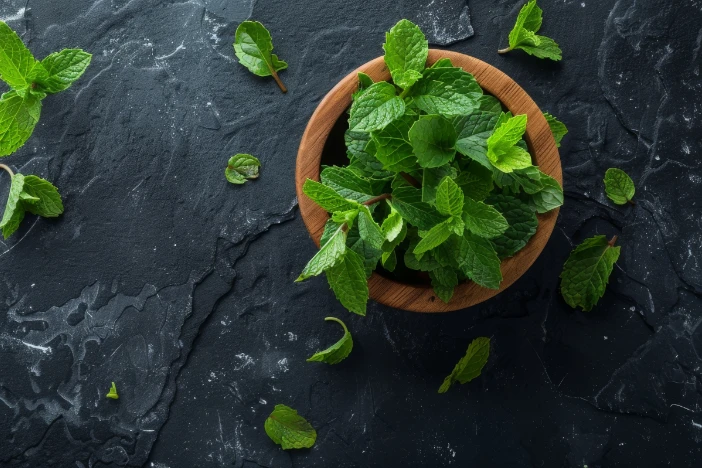
Slate cleaning, care and maintenance
Slate tabletops are attractive and can last if properly maintained. Untreated slate is porous and can stain if not protected by a sealant at least twice a year. This will extend the lifetime of the tabletop by making it more resistant to dirt and spills that may soak into the material.
Treating slate tops
- Lightly dust the tabletop and make sure that the surface is clean and dry
- Move the table to an area that is out of direct sunlight
- Apply the sealant using a lint-free cloth, brush or roll to both sides of the slate
- Wipe off any excess sealant
- Let the surfaces dry for approximately 3 hours
Cleaning tabletops made of slate
It’s pretty easy to clean a slate tabletop once it is treated.
- Wipe the surface using a moist soft cloth with mild detergent and warm water
- Frequently wring out the cloth and re-wet it so that you’re not just spreading the dirt around
- Remove minor stains by spraying them with a mixture of hydrogen peroxide and water
- Lightly scrub the area with a soft-bristled brush or pad
- Let dry in the air
Slate can easily scratch or chip through regular usage. Be careful placing or moving hard-edge items on the table, as they may scratch the surface. Remove minor scratches by lightly sanding the area with fine-grade sandpaper. Dust the area afterward and clean it before re-applying sealant.
Getting tough stains out of slate
Depending on what is spilled, there are several ways to remove stubborn stains from slate counters or tabletops. Don’t use vinegar or other cleaners with acidic ingredients that may degrade the slate. Treat the isolated area, clean it normally and then reapply the sealant.
- Oily marks – Hydrogen peroxide and flour paste covered by plastic wrap overnight
- Tea & coffee stains – Hydrogen peroxide (1 tablespoon) and ammonia (3-4 drops)
- Ink spots – Nail polish remover
Preventive care tips
Preventing damage is often easier and more effective than cleaning up after it. No matter the material, simple preventive steps can extend the life of your outdoor tabletop and reduce maintenance needs. From shielding surfaces from the elements to protecting against daily wear and tear, practical measures can keep your outdoor furniture in pristine condition.
Use coasters, placemats and trivets
Protect all types of tabletops from everyday hazards like drink rings, food stains, hot dishes, and abrasive items.
- Coasters prevent condensation rings from cold drinks and heat damage from mugs or glasses.
- Placemats shield against scratches from plates, utensils, and decorative items.
- Trivets are essential for placing hot cookware or serving dishes, especially on HPL and ceramic surfaces. These can be sensitive to sudden temperature changes or prolonged heat exposure.
This simple habit prevents surface etching, discoloration, and cracking—regardless of the material.
Keep umbrella holes & drainage areas clear
Standing water is a common cause of staining and material breakdown. Porous or textured surfaces like ceramic or slate-look laminates are especially vulnerable.
- Ensure umbrella holes are free of debris, leaves, or blockages that can trap water.
- Use umbrella hole plugs when the umbrella is not in place to keep water out.
- Check for drainage pathways around the base to avoid pooling that can lead to mildew or mineral deposits.
Shield tabletops from prolonged direct sunlight
Continuous exposure to harsh sunlight can degrade many outdoor materials over time:
- HPL and plastic laminates may fade, chalk, or become brittle.
- Glass may show mineral spotting and can overheat.
- Ceramic glazes can dull or discolor, especially in darker tones.
To minimize UV damage:
- Use a patio umbrella to shade the surface during peak hours.
- Consider custom table covers when not in use for extended periods.
- Rotate decorative items regularly to prevent uneven fading or spotting.
Distribute weight evenly to prevent surface stress
Outdoor tables can suffer structural stress or cracking if subjected to uneven pressure:
- When placing heavy planters, decorative centerpieces, or stacked items, spread the weight across a wider area.
- Avoid setting extremely heavy items near the edges or directly over unsupported umbrella holes. This can cause stress fractures and tempered glass or ceramic tops are highly susceptible.
Using a tray or weighted mat under larger objects helps protect both the tabletop and its structural integrity.
Helpful Article
Learn the pros and cons of several tabletop materials in our Outdoor Furniture Materials Guide.
From hard tops to soft fabrics
Outdoor tabletops see a lot of action and require ongoing attention. Surfaces on which food and beverages are served need to be extra clean and free from dirt and germs. Similarly, fabrics used for seating should be cleaned and dried regularly. In the next part of our guide, we look at different fabrics used for upholstery and slings. We will also discuss how to take care of them.
Guide Sections
References
- Ghorbani, M., Mahendran, A. R., van Herwijnen, H. W., Liebner, F., & Konnerth, J. (2018). Based laminates produced with kraft lignin-rich phenol–formaldehyde resoles meet requirements for outdoor usage. European journal of wood and wood products, 76(2), 481-487.

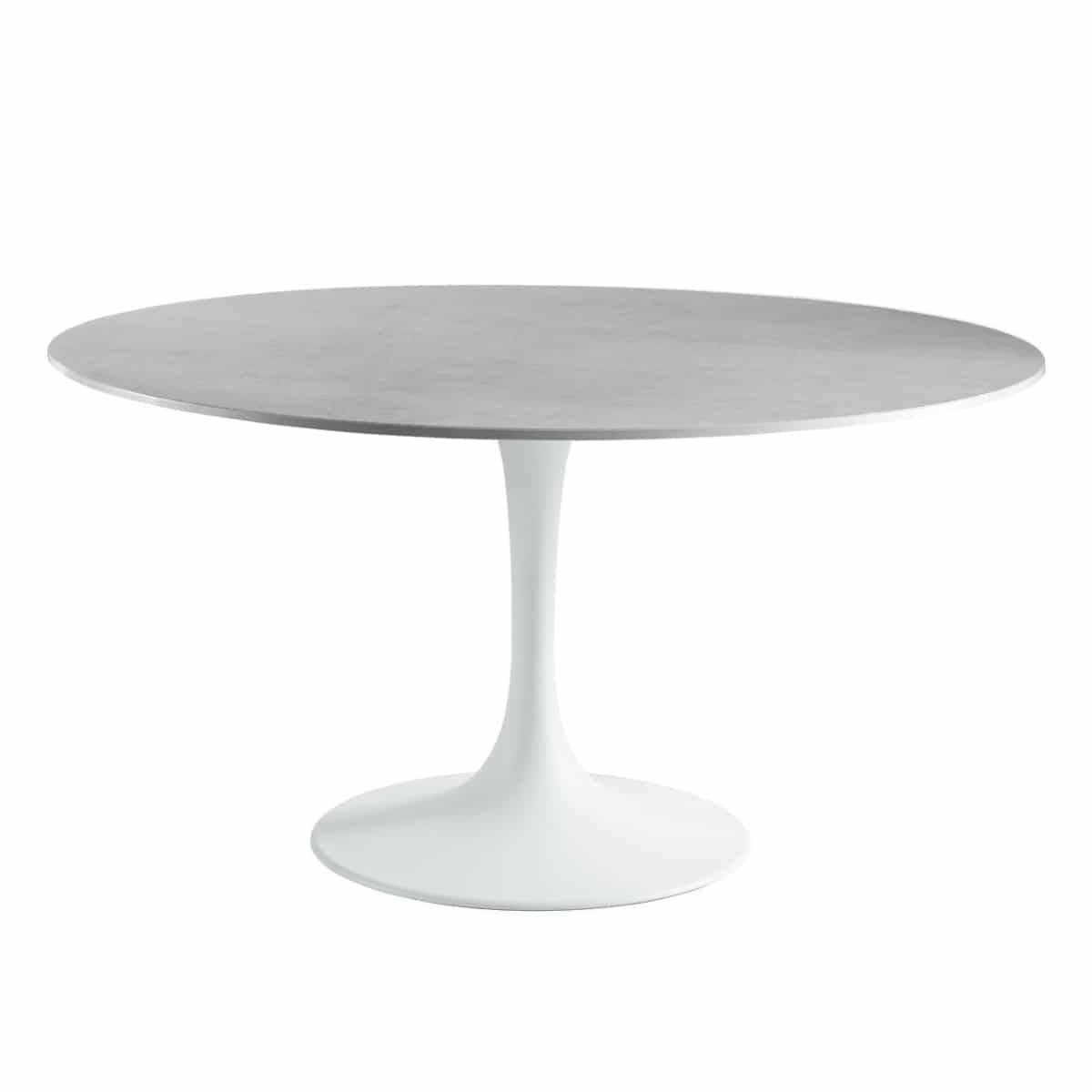
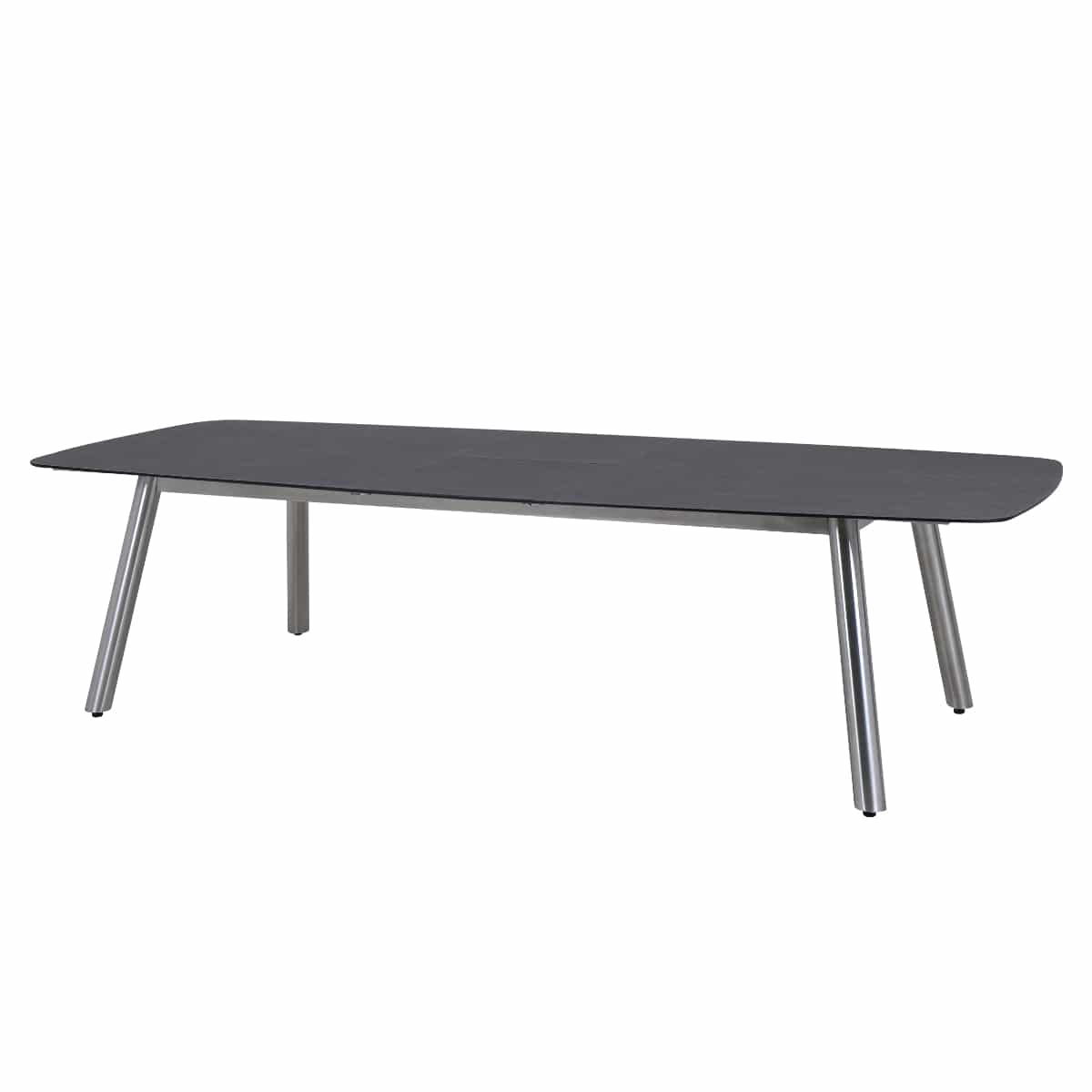
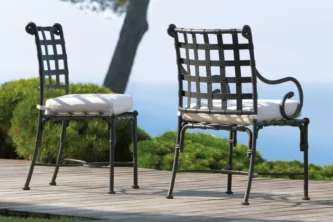
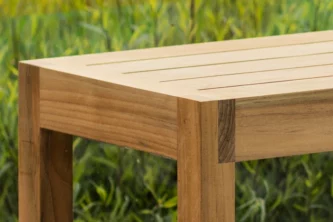
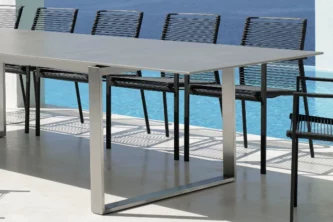
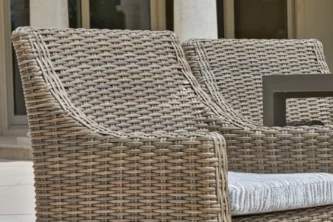
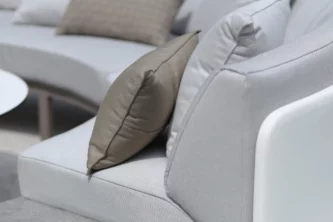





Leave a Reply